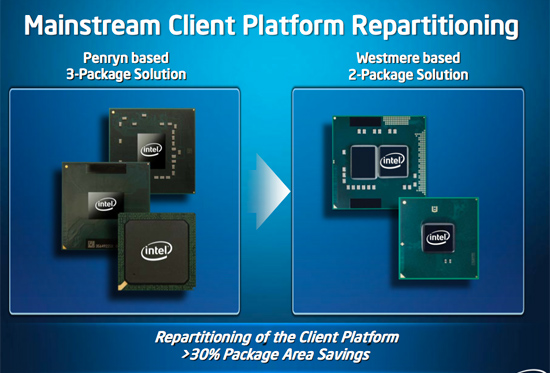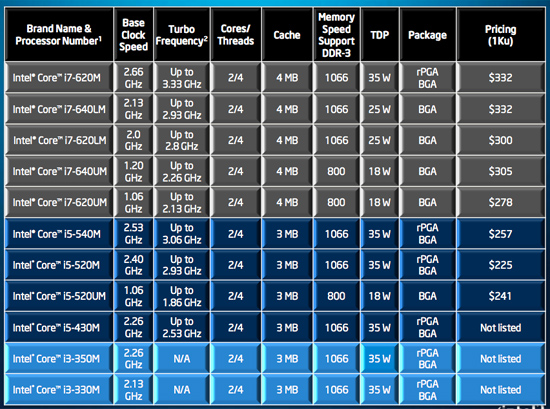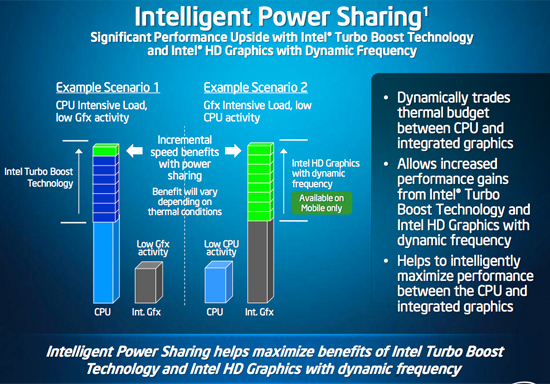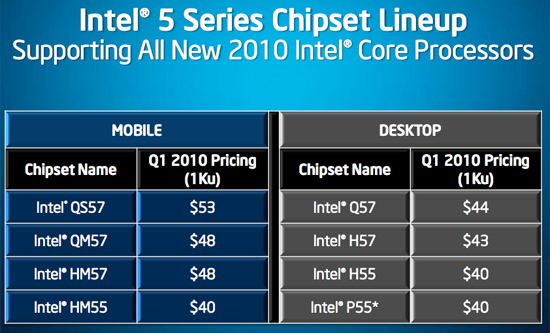Intel Arrandale: 32nm for Notebooks, Core i5 540M Reviewed
by Anand Lal Shimpi on January 4, 2010 12:00 AM EST- Posted in
- Laptops
Clarkdale is the desktop processor, but Arrandale is strictly for my notebooks. The architecture is the same as Clarkdale. You've got a 32nm Westmere core and a 45nm chipset on the same package:

The two-chip solution does matter more for notebooks as it means that motherboards can shrink. Previously this feature was only available to OEMs who went with NVIDIA's ION platform (or GeForce 9400M as it was once known). This is the first incarnation of Intel's 32nm process so it's not quite as power optimized as we'd like. The first mainstream Arrandale CPUs are 35W TDP, compared to the 25W TDP of most thin and light notebooks based on mobile Core 2. Granted the 35W includes the graphics, but it's not always going to be lower total power consumption (more on this later).
The Arrandale lineup launching today is huge. Intel launched 7 Clarkdale CPUs, but we've got a 11 mobile Arrandale CPUs coming out today:

The architecture is similar to Clarkdale. You get private 256KB L2s (one per core) and a unified L3 cache for the CPU. The L3 is only 3MB (like the Pentium G9650) on the Core i5 and Core i3 processors, but it's 4MB (like the desktop Core i5/i3) on the mobile Core i7. Confused yet? I'll have to admit, Intel somehow took a potentially simple naming scheme and made it unnecessarily complex. We also get some low-voltage parts that have 18W TDPs. They run at low default clock speeds but can turbo up pretty high.
Turbo is hugely important here. While Clarkdale's Turbo isn't exactly useful, the TDPs are low enough in mobile that you can really ramp up clock speed if you aren't limited by cooling. Presumably this will allow you to have ultra high performance plugged-in modes where your CPU (and fans) can ramp up as high as possible to get great performance out of your notebook. Add an SSD and the difference between a desktop and a notebook just got even smaller.
Arrandale does have one trick that Clarkdale does not: graphics turbo.

GPU bound applications (e.g. games) can force the CPU part of Arrandale into a low power state, and the GPU can use the added thermal headroom to increase its clock speed. This is a mobile only feature but it's the start of what will ultimately be the answer to achieving a balanced system. Just gotta get those Larrabee cores on-die...
Chipsets are even more complicated on the mobile side:












38 Comments
View All Comments
Alberto - Monday, January 4, 2010 - link
According to www.legitreviews.com/article/1169/15/ and www.legitreviews.com/article/1169/16/ the idle power is very interesting, lower then the older plataform of around 30%.Likely the difference between the two articles is due to a different bios. Moreover Legit has done a lot of tweaks to make the two plataforms comparable (cpu apart). In the battery test, the Monteniva laptop has a 6 cell battery instead of a 8 cell, but the 30% figure seem confirmated.
HotFoot - Monday, January 4, 2010 - link
One thing I've often wondered about battery tests is variability in the batteries themselves. Of course, over time batteries wear out and life goes down - but what about the difference between new batteries, even ones of the same rated capacities?I would be interested to see a review such as this one, but where the battery life is tested twice - swapping batteries between platforms and taking the average. Some adaptation will probably be needed. Or, maybe a standard battery testbench used for all battery life tests - which would involve adapters for each notebook.
My point is uncertainty. I know it's not an academic paper, but if the variability in results is 10% or higher (which my gut tells me it very well may be with batteries), the conclusions drawn from the results could be radically different. Maybe it's not that bad, and a few tests into the subject would demonstrate that.
JarredWalton - Monday, January 4, 2010 - link
I had http://www.anandtech.com/mobile/showdoc.aspx?i=361...">two Gateway laptops that had the same battery design, only one was Intel-based and the other was AMD-based. After a request similar to yours, I swapped the batteries and retested. Variability was less than 2%, which is the same variability between test runs.kazuha vinland - Monday, January 4, 2010 - link
Your unit was obviously just a prototype, but can we expect to see the first Arrendale laptops arriving this or next month?webmastir - Monday, January 4, 2010 - link
love reading your reviews - very insightful. thanks.8steve8 - Monday, January 4, 2010 - link
when can we expect reviews of these ULV processors?when can we expect laptops with these ULV processors?
strikeback03 - Monday, January 4, 2010 - link
And seriously, wtf was intel thinking with these names? 5 processors, all at different speeds, with either 640 or 620 in the name. If a 620LM was the same speed as a 620UM but just used less power I could see it, but there are 3 processors with 620 in the name, running at 1.06, 2.0, and 2.66GHz. The consumer also has to know that a 620M is faster than a 640LM.ET - Monday, January 4, 2010 - link
I'd love to see more comprehensive mobile benchmarks, but it looks like finally Intel graphics isn't the complete crap it used to be.yuhong - Monday, January 4, 2010 - link
On Intel codenames, "Clarksfield" can be easily confused with the desktop "Clarkfield".yuhong - Monday, January 4, 2010 - link
Oops, I mean Clarkdale by Clarkfield.